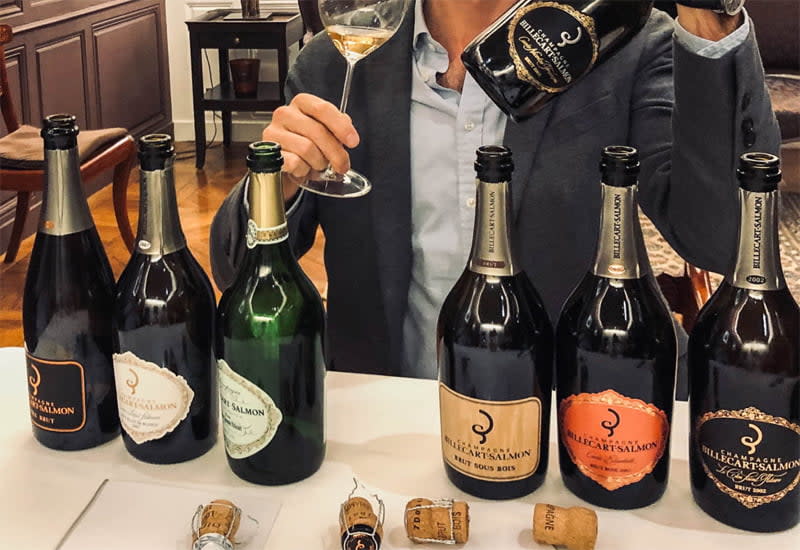The 200-year-old Williamecart Salmon Champagne House has always managed to please wine drinkers and critics, thanks to constant improvements in the winemaking process and an incredible selection of cuvees!
Interestingly, the 1959 Billecart-Salmon Cuvee Nicolas Francis was named “Champagne of the Millennium” by a panel of experts during a blind tasting of three days in Stockholm in 1999. (outshining Dom Perignon, Ruinart, and Krug.)
So, what makes these champagnes stand out from all the others? What Billecart Salmon bottles should not be missing in 2023?
Explore this tiny Champagne house’s history, winemaking processes, and vineyards. We’ll look at its cuvees, investment possibilities, and the simplest method of buying the bottles of wine.
The Billecart Salmon Champagne House
The Billecart Salmon Champagne House is situated in Mareuil-sur-Aÿ, France, and is one of the few Champagne houses still family-owned.
This prestigious winery creates Champagne using Pinot Noir, Chardonnay, and Pinot Meunier grapes sourced from its vineyard and over 300 hectares of grower vineyards.
Like many Champagne houses, Billecart Salmon is known for its preference for Pinot Meunier in its blends. Indeed, its most popular Wine, Brut Rose Champagne, has more than 30 percent Pinot Meunier.
Billecart Salmon offers a wide selection of Champagnes available in its stable. On top of the listing is its exclusive The Clos Saint Hilaire and the Cuvee Nicolas Francois Billecart.
The Vineyards of Billecart Salmon
Billecart Salmon obtains their wine grapes from 14 hectares of House-owned vines and grower vines from 40 crus across Champagne (mostly around Epernay.)
It is believed that the Pinot Noir, Chardonnay, and Pinot Meunier grapes come from the beautiful Grand Cru terroir of Montagne de Reims, Vallee de la Marne, and the Cote des Blancs.
Billecart Salmon practices some biodynamic principles in their vineyards, including avoiding using herbicides and pesticides.
Yields are reduced to increase the quality of the wine, and the harvest can be later. The house’s premise is that early crops yield an elegant and delicate Champagne.
Production is limited to 2.5 million bottles per year.
The crown of Billecart Salmon’s wine estate is the piece of the land Le Clos Saint Hilaire.
Pinot Noir vineyards exclusively plant the vineyard. The hectare comprised of Pinot Noir vines is enclosed by a stone wall and plowed by horses. The grapes are used to create the vintage Clos Saint-Hilaire Champagne. It is limited to 3,500 – 5,500 each year.
Champagne Brut Reserve
The Brut Réserve is a light, subtle blend of 40% Pinot Meunier, 30% Pinot Noir and 30% Chardonnay.
Vinification and malolactic fermentation are performed within tanks made of stainless steel. The Champagne comprises 50% to 60% reserve wine and is matured over 30 years on lees.
The aging process after release is based on the bottle’s format and can last between 2-4 years for the standard bottle and 1-2 years for half bottles, as well as up to eight years with jeroboams and magnums.
The elegant Billecart salmon Brut Reserve has a delightful fresh pear, orange peel, and apple blossom aroma. The rich, long-lasting mousse is complemented by a rich and refined taste of red fruit, tempered by a juicy acidity (a mouthwatering acidity!) and ends with a light earthiness.
Other Billecart Salmon Cuvees
Billecart Salmon has produced several limited-edition covers over the years:
Made from 100 percent Chardonnay of the Cote des Blancs Grand Crus. This sparkling wine is made with buttered Brioche notes and a refined minerality.
Champagne Brut Nature: This is a blended wine consisting of 30 percent Pinot Noir, 30% Chardonnay, and 40 percent Pinot Meunier with no added sugar to the dose. It has lovely notes of brioche as well as dried fruit.
Champagne Brut Sous Bois: This distinctive cuvée is made using only oak and comprises three major Champagne grape varieties. The notes on the Brut Sous-Bois include the grilled brioche, strawberries, and a fresh lemon.
Champagne Vintage: Pinot Noir aromas dominate the blend made up made up of Grand Cru and Premier Cru grapes.
Champagne Demisec: The Demisec blend is like the Brut Reserve but is a much more significant amount. The notes on the tasting include brioche that has been toasted as well as white blooms.
Ndeg1 Meunier Extra Brut The Ndeg1 Meunier Extra Brut is the first release of the Les Rendezvous de Billecart Salmon series. It is made of 100 percent Pinot Meunier. It is a smooth, long-lasting mousse scented of ripe pear and light earthiness.
We will now examine the investment possibilities of Billecart Salmon bottles.
Investing in Billecart Salmon Champagne
Billecart Salmon wines are comparable to the likes of Krug and Dom Perignon but with prices that tend to be much more approachable.
This vintage of 2002 is listed at around $190 plus; the 1996 vintage is priced at $310+, while the vintage of 2006 is priced at $ 160 plus. This means that 2005’s Cuvee Nicolas Francois is a considerable bargain, particularly compared to similar vintages other producers offer. For instance, the 2006 Dom Perignon Oenotheque costs $ 620 plus, while the 2006 Dom Ruinart Blanc de Blancs Brut is priced at $ 180 or more.
Let’s look at one of the most well-respected cuvees: the classic Nicolas Francois Champagne. The 2003, 2006, and 1996 vintages received a score of 95+ from experts like Robert Parker and websites such as Wine Enthusiast and Wine Spectator.
The previous vintages, such as the 2000, 2002, 1998, 1999, and 1996, have seen an average of around 8% per year.
Also, approachable pricing and potential for long-term aging make Billecart Salmon’s most sought-after cuvees in a compelling position for investors to think about.
What’s the most efficient method to get these fantastic Cuvees of Champagne that are sought-after?
You can go with the wine retailer online, at the wine shop, or an auction. This involves looking up prices and confirming the authenticity of the wine, as well as shipping, ins, insurance, and storage. You could quickly get Vinovest HTML2 to assist you.

